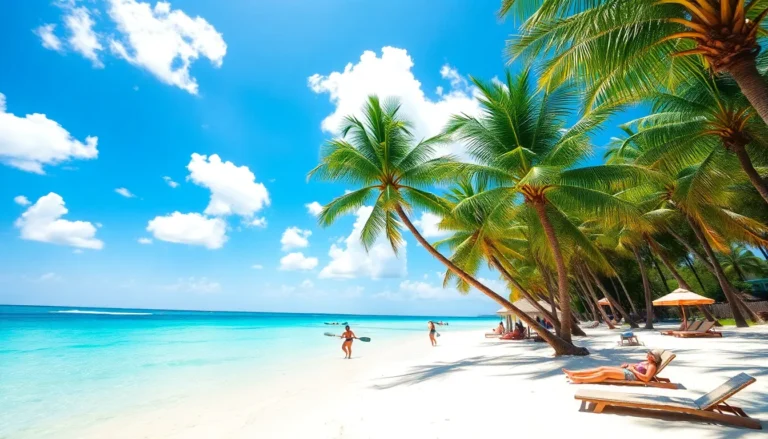Imagine bustling streets, vibrant cultures, and breathtaking scenery, that’s the essence of the most tourist countries in the world. Every year, millions flock to their favorite destinations, adding to the rich tapestry of global travel and hospitality. But have you ever wondered what makes a particular country so irresistible to tourists? Buckle up as we jump into a world of adventure, culture, and, dare we say, a little chaos. Whether it’s for those irresistible Instagram shots or culinary delights worth every calorie, the allure of these countries is simply magnetic.
Table of Contents
ToggleOverview of Global Tourism Trends

Tourism has transformed dramatically over the last few decades. From the rise of budget airlines making travel more accessible, to the digital revolution enhancing how we plan our trips, these trends create a fascinating landscape. According to the United Nations World Tourism Organization (UNWTO), international tourist arrivals reached 1.5 billion in recent years, showcasing an ever-growing appetite for travel. Interested in how specific countries are adapting? Let’s explore.
Global tourism reflects societal changes and economic dynamics. Countries with strong hospitality sectors not only welcome tourists but also innovate their tourism approaches to keep up with evolving preferences. For instance, more travelers are seeking authentic experiences rather than traditional sightseeing. So what do these changes mean for the world’s top tourist countries?
Top Tourist Countries and Their Attractions
When thinking of the most tourist countries, a few names jump to mind. Countries like France, Spain, the United States, and Italy continuously capture the hearts of wanderers. But what makes these places so appealing? Let’s break it down.
Factors Contributing to Popularity
Tourist countries thrive due to a mix of autonomous factors. Accessibility is paramount: direct flights and efficient public transport systems make travel smoother. Also, robust marketing campaigns and strategic partnerships can elevate a destination’s allure. When countries project positive images, people want to visit.
Cultural and Historical Significance
History resonates in the cobbled streets of Rome, through the art-laden museums of Paris, and in the vibrant heritage of Tokyo. These places are more than just spots on a map, they are living stories. Tourists inherently seek to immerse themselves in culture, fueling the desire to explore. Cultural festivals, culinary treats, and historical landmarks all play significant roles in this narrative.
Natural Wonders and Scenic Beauty
Mother Nature outdoes herself in these countries. Think of the breathtaking fjords of Norway or the lush landscapes of New Zealand. The stunning visual appeal often drives the choice of destination. Nature enthusiasts revel in discovering unique ecosystems, while adventure seekers aim for the thrill of hiking trails, mountains, and beaches.
Travel Infrastructure and Accessibility
What good is a beautiful destination without a means to get there? Exceptional infrastructure is the backbone of tourism. High-quality hotels, accessible restaurants, and dependable public transportation make travels easier and more enjoyable. Countries also recognize the importance of accommodating guests with mobility challenges.
Economic Impact of Tourism
The economic implications of tourism can be monumental. Countries often depend on tourism as a crucial economic driver, generating revenue and creating jobs. In fact, employment in tourism sectors can account for a significant percentage of available positions in a nation. This revenue supports local businesses and enhances community infrastructure.
Besides, tourism fosters international relations and cultural exchange. When travelers spend their dollars in a local economy, they cultivate links between nations and communities. This interdependence promotes a more integrated world, where shared experiences and global understanding flourish. To conclude, while tourism creates financial opportunities, it also enriches lives globally.
Challenges Facing Tourist Countries
Even though the numerous benefits, countries face significant challenges in their quest to maintain thriving tourism sectors. As cities become overwhelmed with visitors, they struggle to manage the delicate balance between catering to tourists and preserving local life.
Future of Global Tourism
The pandemic has forever altered the tourism landscape, pushing countries to reconsider their approaches. Flexible travel policies and increased health measures are now common practice, as are enhanced digital experiences. The future leans towards safer, tech-savvy travel solutions that prioritize both tourists and locals.
Sustainable Tourism Practices
Sustainability has surged to the forefront as well. Tourists now frequently prioritize eco-friendly options. Countries must invest in sustainable infrastructure, preserve natural wonders, and support local economies responsibly. The shift towards environmentally conscious travel ensures that future generations can enjoy these beautiful places.
Emerging Destinations to Watch
While established tourist nations remain strong, emerging destinations merit attention. Think of places like Cambodia, Portugal, or even Bhutan. Each of these offers unique experiences combined with rich traditions and stunning sights. Social media and the rise of travel blogs accelerate the popularity of lesser-known gems. More tourists are exploring beyond the beaten path, creating a broader map of travel. This diversification enriches global travel and fosters curiosity.





